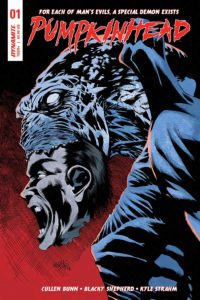 Vengeance is the demon most easily satisfied
Vengeance is the demon most easily satisfied
Creative Staff:
Story: Cullen Bunn
Art: Blacky Shepherd, Kyle Strahm (backup story)
Colors: Thiago Ribeiro
Letterer: Troy Peteri
What They Say:
“For each of Man’s evils, a special demon exists.”
For thirty years, the demon of vengeance has been still, its corpse buried in a pumpkin patch graveyard in the hills. But when a reckless driver accidentally kills a pair of children, the creature is called up once more. This time, though, the monster’s intended target is protected by a cruel backwoods crime family. They hatch their own supernatural plans for dealing with Pumpkinhead. For each of man’s sins, a special demon exists, and when seven infernal creatures roam the hills and the hollows, no one–guilty or otherwise–is safe.
Plus! The first part in a backup story about everyone’s favorite, Haggis, by Cullen Bunn and Kyle Strahm!
Content: (please note that content portions of a review may contain spoilers):
Few horror films of the early 1980s found a way to combine traditional monsters with modern life like Pumpkinhead. Directed by special effects wizard Stan Winston, it never pandered to the technology. It never wallowed in camp. Instead, it developed simple, relatable characters and tied it together with the gut punch of human pain and rage. When the monster appeared it was the embodiment of what the characters, and the audience, felt. It gave us a glimpse of our own internal struggle let loose on the world to give us what we thought we wanted. Horror came from seeing our inner demon out of control on the world. When I saw Dynamite was releasing a comic reboot of the character, well, my biggest fear was it would go against the structure of Winston’s world.
Penned by Cullen Bunn, whose own rural horror has become a contemporary staple, it pays homage to the source by maintaining the sense of order of the original film. Bunn sets his Pumpkinhead in a place where suburban sprawl, ie. the contemporary rural south, meets the truly rural pockets of isolated hillbillies. For the uninitiated, Appalachian and Southern communities were first settled by people who placed family first and held everyone else at a distance. This came from disparate cultural elements of being exiled from their countries of origin, seeking freedom of religion or government, or simply they lived in the isolation of being disconnected from the rest of the country. Whether from distrust of the government or their neighbors, the rural settlers dug in and developed unique, and to outsiders, frightening ways of dealing with the world.
Bunn follows the path of the original movie and the very real tendency of these isolated populations to deal with situations on their own. This story centers around the death of children caused by an outsider. It appears the outsider is there to mule Oxycodone. He is being kept “safe” by a local with a long beard and a pentagram tattoo on his hand. We see scenes in the jail where a local tells the sheriff something is going to happen to the killer. He is sort of a cross between a southern punk and a 1% biker. The police seem to be in the dark about the local customs. It seems that the demons exist only in the knowledge of the hill folk, and they don’t want to talk to any outsiders.
Anyone who has seen the film can guess what will happen. Someone wants Pumpkinhead to deal vengeance on the baddies. Doing this in the spirit of Winston’s creation means the monster must stay somewhat in the shadows to keep up the suspense and make the horror potent. To Blacky Shepherd’s credit, he draws scenes where people react without seeing the monster, illustrating confusion and fear while saving the full reveal for a single panel that punctuates the emotions of the characters. Together, Bunn and Shepherd create a world that is resonates between stereotypes and archetypes, creating hill folk who operate at the same level as the contemporary suburbanites. In other words, they don’t stoop to condescending depictions which allows all of the characters to inhabit a realistic world.
Thiago Ribeiro’s colors paint a world of dreamy landscapes and stark characters. While this sets the tone of the action, it also creates palates for the different cultural and emotional spaces. With so many transitions in so few pages, the differences will be noticed which is a subtle way of guiding the reader without complicating the story or art.
In an additional story, Bunn and artist Kyle Strahm further develop the world by imparting a narrator who talks about the demons. I hesitate to compare this to the E. C. narrators that combined ironic humor with morals and a punchline because it is not. What they have created is a narrator who develops the world’s mythology through harsh black monochrome art filled with camp and decay. The extreme difference in the art style allows world building without infringing on the main story. It works well at what it tries to do.
In Summary:
Pumpkinhead isn’t just for the fans of the movies. It develops a world that stays true to the mythos while ushering in a contemporary story that will appeal to a variety of readers. Bunn’s text and Shepherd’s art do not operate in the cinematic scope of a blockbuster. They build claustrophobic scenes confined to the panels of a comic. This both complements and homages the Pumpkinhead universe. While I don’t judge a series on the first issue, the creators have a plan, and they have succeeded in laying a solid foundation for a good monster story.
Grade: A-
Age Rating: Teen +
Released By: Dynamite
Release Date: February 21st, 2018
MSRP: $3.99



